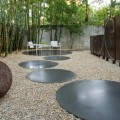Houston Garden Design
Exterior Worlds customizes Houston garden design to the neighborhood of the residence, the architecture of the home, and the lifestyle of the client. With us, you get far more than a garden planted in front of or behind your home. You get an organic expression of your own personal lifestyle integrated into the fabric of your property.
In the Memorial area of Houston, garden design works to compliment ranch style houses that sit perched on expansive lots with large trees. This part of the city, although very close to the Galleria, has a distinctively rural feel to it. In fact, there are many Houston suburbs that appear far more urban and developed than this area located very near to the heart of the city.
To fully support this sensibility, Exterior Worlds designs more casual, country gardens here. The large amount of space that Memorial Area lots give us to work with allows us to create a sweeping sense of life throughout significant portions of both the front and back yards. Due to the large population of pine and oak trees which tower above the landscape, there are also many opportunities to plant natural gardens that create a forest-like feeling in the back yard.
The River Oaks area is, of course, Houston’s wealthiest and most elite neighborhood, and world famous for its Country Club and magnificent mansions. Since so many of the larger homes here have an architecture that is either definitively Old World or Colonial in style, Houston garden design must be very formal.
Lots in River Oaks are very large, and many of the homes date back to the 1920’s. The trees here are also some of the oldest in Houston. Some are even survivors of the indigenous Magnolia forest which was all but cut down to build the city’s railroad system. So many layers of history have been overlaid on top of one another in River Oaks since that time that Houston garden design specialists must use great care and creativity when planting any garden.
There are always unknown factors which pop up in these projects, ranging from challenging renovations that have previously been done to the house, to buried utility lines, to tree roots that have to be carefully preserved in order to avoid killing the trees themselves. Still, the rewards are always well worth the challenges when one admires a River Oaks rose garden, or a traditional parterre garden stretching behind a 10,000 square foot home.
Italian gardens and French gardens are also popular base forms here due to their linearity and formality—but customized at the same time in consideration for the highly unique characteristics of each and every individual property in this area.
In Tanglewood, we see very large lots built in the 1960s. The terrain here is very flat. Large water oak and live oak abound everywhere. Originally, home styles here mirrored those in the adjacent Memorial neighborhood, having been originally constructed as ranch-style homes. Now, Tanglewood is seeing a transformation toward custom home styles exceeding 6,000 square feet in size.
The large lot sizes allow us to create a variety of natural and county-style garden forms when appropriate to home architecture. Rose gardens work very well with many of the yards here. In places around the newer custom homes, more innovative and highly individualized deviations of traditional Houston garden forms have to be planted to properly respect the persona that the new home projects toward the neighborhood. Front yard landscaping and gardens are very important here in order to give each new home a distinguished look that contributes to the feeling that of a significantly upgraded property.
In Bellaire and West University, Houston garden design takes a much different direction due to the sizes of the homes and the lots. Many properties here are very small, and the homes range from smaller wooden homes to very large homes that have recently replaced original structures. The gardens we plant here tend to be very small, geometrical, and many in number. This helps create the illusion that the property is larger than it is.

